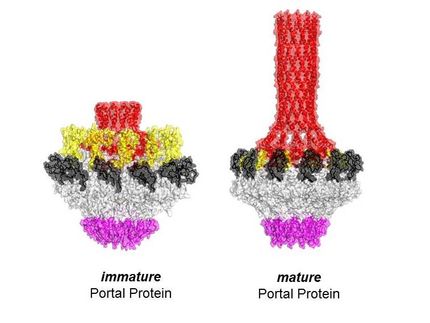Study uncovers how herpesvirus spreads
Discovery could lead to ways to trap herpesvirus before it spreads
Herpesviruses are thrifty reproducers - they only send off their most infectious progeny to invade new cells. Two Cornell virologists recently have discovered how these viruses determine which progeny to release.
The College of Veterinary Medicine researchers report in Proceedings of the National Academy of Sciences on the mechanisms of this quality-control system, which helps streamline viral reproduction to optimize its spreading.
The virologists identified proteins in the nuclear membranes of infected cells that control which viral products exit. This map could be used to identify new targets for future drugs that would hamper viral reproduction by clogging inspection pathways to trap viruses in the cells they first infect.
"When a herpesvirus hijacks a cell, it turns the nucleus into a viral production factory," said Joel Baines, the James Law Professor of Virology, who co-authored the study with postdoctoral research associate Kui Yang. "It makes protein shells called capsids, stuffs them with viral DNA and ships them out of the nuclear membrane to infect new cells. But errors in the assembly line leave some capsids empty, without DNA, and shipping these is a waste of resources."
When capsids bud from the nuclear membrane, they take pieces of it with them, forming protective lipid envelopes that let them move to new cells. Empty capsids can't reproduce, so the virus only allows capsids with DNA through. How the membrane could determine whether the capsid had DNA or not was a mystery until Yang and Baines mapped its method.
"We found clamplike proteins on the surface of herpesvirus capsids that hold them together and keep them from bursting when they're stuffed full of DNA," said Baines. "Those with DNA have far more of these than empty capsids. We also found a protein complex living in the host cell's nuclear membrane that binds to these structural support proteins, selecting DNA-filled capsids to pull through the membrane. Thus the virus releases only its most infectious particles."
This streamlining process has helped herpesvirus species spread prevalently and permanently across all animal species. Eight of the 25 known viruses in the herpes family regularly infect humans, posing a leading cause of human viral infection.
Once in a body, herpesvirus stays for life. It can flare up at any time, causing symptoms and diseases, ranging from infected sores to brain inflammation, birth defects and cancers of the nose, throat and lymphatic system. Though usually not fatal, herpes can prove dangerous to patients with weak immune systems, such as those with HIV/AIDS or infants who contract HIV/AIDS from their mothers.
There is no cure for herpes, but Baines' map illustrates a viral reproduction system that can be subverted.
"Take away either component, the capsid's clamplike proteins or the membrane's inspector proteins, and nothing escapes the host cell," said Baines. "This opens the door to developing drugs that could block the interactions between these protein complexes, covering the binding sites to clog the system so that no viral particles get through. This would significantly slow or even stop the virus's spread between cells. Our lab is now working on even more detailed maps of these proteins' exact interaction sites that will help drug developers pinpoint precise targets to thwart viral reproduction."
Most read news
Other news from the department science

Get the life science industry in your inbox
By submitting this form you agree that LUMITOS AG will send you the newsletter(s) selected above by email. Your data will not be passed on to third parties. Your data will be stored and processed in accordance with our data protection regulations. LUMITOS may contact you by email for the purpose of advertising or market and opinion surveys. You can revoke your consent at any time without giving reasons to LUMITOS AG, Ernst-Augustin-Str. 2, 12489 Berlin, Germany or by e-mail at revoke@lumitos.com with effect for the future. In addition, each email contains a link to unsubscribe from the corresponding newsletter.






















































